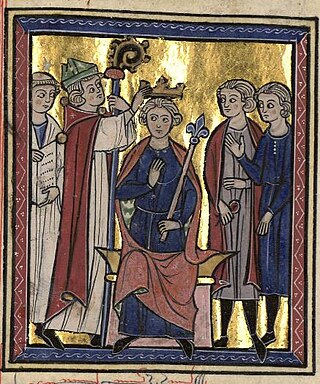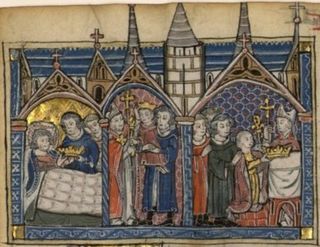
Amalric, formerly known in historiography as Amalric I, was the king of Jerusalem from 1163 until his death. He was, in the opinion of his Muslim adversaries, the bravest and cleverest of the crusader kings.

Year 1137 (MCXXXVII) was a common year starting on Friday of the Julian calendar.

Melisende was the queen of Jerusalem from 1131 to 1152. She was the first female ruler of the Kingdom of Jerusalem and the first woman to hold a public office in the crusader kingdom. She was already legendary in her lifetime for her generous support of the various Christian communities in her kingdom. Contemporary chronicler William of Tyre praised her wisdom and abilities, while modern historians differ in their assessment.

Baldwin III was King of Jerusalem from 1143 to 1163. He was the eldest son of Queen Melisende and King Fulk. He became king while still a child, and was at first overshadowed by his mother Melisende, whom he eventually defeated in a civil war. During his reign Jerusalem became more closely allied with the Byzantine Empire, and the Second Crusade tried and failed to conquer Damascus. Baldwin captured the important Egyptian fortress of Ascalon, but also had to deal with the increasing power of Nur ad-Din in Syria. He died childless and was succeeded by his brother Amalric.

Fulk, also known as Fulk the Younger, was King of Jerusalem with his wife, Queen Melisende, from 1131 until his death in 1143. Previously, he was Count of Anjou, as Fulk V, from 1109 to 1129. During Fulk's reign, the Kingdom of Jerusalem reached its largest territorial extent.

Raymond III was count of Tripoli from 1152 to 1187. He was a minor when Nizari Assassins murdered his father, Count Raymond II of Tripoli. His cousin King Baldwin III of Jerusalem, who was staying in Tripoli, made Raymond's mother, Hodierna of Jerusalem, regent. Raymond spent the following years at the royal court in Jerusalem. He reached the age of majority in 1155, after which he participated in a series of military campaigns against Nur ad-Din, the Zengid ruler of Damascus. In 1161 he hired pirates to pillage the Byzantine coastline and islands to take vengeance on Byzantine emperor Manuel I Komnenos, who had refused to marry his sister Melisende. He was captured in the Battle of Harim by Nur ad-Din's troops on 10 August 1164, and imprisoned in Aleppo for almost ten years. During his captivity, his cousin King Amalric of Jerusalem administered the county of Tripoli on his behalf.

Pons was count of Tripoli from 1112 to 1137. He was a minor when his father, Bertrand, died in 1112. He swore fealty to the Byzantine Emperor Alexios I Komnenos in the presence of a Byzantine embassy. His advisors sent him to Antioch to be educated in the court of Tancred of Antioch, ending the hostilities between the two crusader states. Tancred granted four important fortresses to Pons in the Principality of Antioch. Since Pons held his inherited lands in fief of the kings of Jerusalem, Tancred's grant strengthened the autonomy of the County of Tripoli. On his deathbed, Tancred also arranged the marriage of his wife, Cecile of France, to Pons.
Constance of Hauteville was the ruling princess of Antioch from 1130 to 1163. She was the only child of Bohemond II of Antioch and Alice of Jerusalem. Constance succeeded her father at the age of two after he fell in battle, although his cousin Roger II of Sicily laid claim to Antioch. Alice assumed the regency, but the Antiochene noblemen replaced her with her father, Baldwin II of Jerusalem. After he died in 1131, Alice again tried to take control of the government, but the Antiochene barons acknowledged the right of her brother-in-law Fulk of Anjou to rule as regent for Constance.

Hodierna of Jerusalem was the countess of Tripoli through her marriage to Raymond II of Tripoli. She ruled the County of Tripoli as regent during the minority of their son Raymond III from 1152 until 1155.
Alice of Jerusalem was the princess of Antioch from 1126 to 1130 and, from 1130 to 1136, a contender for the regency of the principality. Because of her ambition to rule she is unfavorably portrayed by the chronicler William of Tyre, who is the main narrative source of information about her life. William's hostile account has affected the historiographical assessment of Alice's career.
Ioveta was a Latin princess from the crusader Kingdom of Jerusalem. Her name appears in various other forms, including Joveta, Yveta, Yvette, Ivetta, and Juditta. She headed the Convent of Saint Lazarus in Bethany, the richest abbey in the kingdom, from the late 1130s or early 1140s until her death.

The siege of Edessa took place from 28 November to 24 December 1144, resulting in the fall of the capital of the County of Edessa to Zengi, the atabeg of Mosul and Aleppo. This event was the catalyst for the Second Crusade.
Melisende of Tripoli was a princess from the Latin East who was betrothed to the Byzantine emperor Manuel I Komnenos. She was the daughter of Hodierna of Jerusalem and Count Raymond II of Tripoli. Her cousin King Baldwin III of Jerusalem suggested her as the bride to the emperor, who agreed. Preparations were made for the marriage, and the nobility of the Latin East considered Melisende the future Byzantine empress. After long delays, however, the emperor declared that he would not marry Melisende. This severely affected Byzantine relations with the Latin East.

Cecile of France was a Frankish princess who became countess of Tripoli. She was the daughter of King Philip I of France and Bertrade de Montfort.
William of Bures was Prince of Galilee from 1119 or 1120 to his death. He was descended from a French noble family which held estates near Paris. William and his brother, Godfrey, were listed among the chief vassals of Joscelin of Courtenay, Prince of Galilee, when their presence in the Holy Land was first recorded in 1115. After Joscelin received the County of Edessa from Baldwin II of Jerusalem in 1119, the king granted the Principality of Galilee to William. He succeeded Eustace Grenier as constable and bailiff in 1123. In his latter capacity, he administered the kingdom during the Baldwin II's captivity for more than a year, but his authority was limited.

The Council of Acre met at Palmarea, near Acre, a major city of the crusader Kingdom of Jerusalem, on 24 June 1148. The Haute Cour of Jerusalem met with recently arrived crusaders from Europe, to decide on the best target for the crusade. The Second Crusade had been called after the fall of Edessa to Zengi in 1144. In 1147, armies led by Conrad III of Germany and Louis VII of France began their separate journeys to the east. Conrad arrived at Acre in April 1148, and Louis marched south from Antioch.
In the Battle of Ba'rin in 1137, a Crusader force commanded by King Fulk of Jerusalem was scattered and defeated by Zengi, the Atabeg of Mosul and Aleppo. This setback resulted in the permanent loss of the Crusader castle of Montferrand in Baarin.
This chronology presents the timeline of the Crusades from the beginning of the First Crusade in 1095 to the fall of Jerusalem in 1187. This is keyed towards the major events of the Crusades to the Holy Land, but also includes those of the Reconquista and Northern Crusades as well as the Byzantine-Seljuk wars.

The history of the County of Tripoli, a crusader state in the Levant, spans the period between 1103 and 1289. The county was established in the aftermath of the First Crusade by the Toulousian crusader leader Raymond of Saint-Gilles. He laid siege to the city of Tripoli with Byzantine support in 1103. Although the city resisted, Raymond adopted the title of count of Tripoli in the same year. After he died of wounds, his kinsman Willam Jordan assumed the command of the siege but his claim to rule was challenged by Raymond's son Bertrand who came to the Levant in 1109. William Jordan was assassinated and a large assembly of troops from all over the Latin East captured the city with Genoese and Pisan naval support in June 1109.
Bertrand was the illegitimate son of Alfonso Jordan, Count of Toulouse. Bertrand accompanied his father to the Levant during the Second Crusade. Instead of returning to his homeland after the crusade, he captured 'Urayma, a fortress in the County of Tripoli in 1148 or 1149, reportedly in an attempt to seize the whole county from his kinsman Count Raymond II. Raymond persuaded two Syrian Muslim rulers Nur al-Din and Unur to attack 'Urayama. They captured Bertrand, and he lived in captivity until 1159. This year he was set free due to an agreement between Nur al-Din and the Byzantine Emperor Manuel I Komnenos about the release of Nur al-Din's Christian prisoners. No more detail of his life is known.















